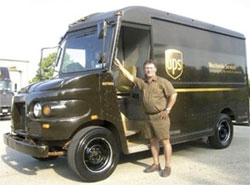Today, President Obama announced he is directing the EPA and Department of Transportation to develop the next phase of fuel economy standards for medium- and
heavy-duty vehicles – the most polluting vehicles on the road.
In 2011, EPA implemented standards that run from 2014-2018 – the first fuel economy standards ever developed for the US heavy-duty vehicle fleet. The new standards will apply to vehicles manufactured after 2018: commercial trucks, buses and school buses, heavy-duty pickup trucks and vans, and vocational trucks like delivery and garbage trucks, many of which still get only 6 miles per gallon.

Like the standards for cars and light trucks, which require 54 miles per gallon by 2025, they can be implemented using mostly off-the-shelf technologies that are available today.
What’s the Impact?
Standards in place for 2014-2018, which go into effect this year, are expected to cut annual oil consumption by 390,000 barrels per day in 2030 – about $50 billion in fuel costs. Estimates are 40,000 new economy-wide jobs in 2020 and nearly 80,000 jobs in 2030, according to the Union of Concerned Scientists.
This new round of standards will have much more impact because they will include fuel saving technologies
across all components of a vehicle.
In the case of tractor trailers, for example, current standards only apply to the truck that’s pulling the trailer, but not the trailer itself. Improving the trailer would increase fuel savings from 23% to 35%.
"According
to the analysis in our Half the Oil plan, improving the fuel efficiency of all
types of heavy-duty trucks could reduce oil consumption by 1 million barrels a
day in 2035, more than the maximum capacity of the Keystone XL pipeline, says Michelle Robinson, director of Union of Concerned Scientists’ Clean Vehicles Program.
How They Work
For the 2014-2018 rules, there are specific targets for each kind of vehicle and within each category, even more specific targets apply based on the design and purpose of the vehicle. This flexible structure allows serious but achievable fuel efficiency improvement goals charted for each year and for each vehicle category and type.
- Commercial trucks have to increase fuel economy 20% beginning in 2014
- Heavy duty pickup trucks and vans have to increase fuel economy 15% by 2018
- Vocational vehicles like garbage trucks, buses and fire engines have to increase fuel economy 10% by 2018.
The new standards, expected to be announced by March 2015, would apply for models years 2019 and after.
In making today’s announcement, President Obama again called on Congress to:
- use revenue from offshore oil drilling to pay for research on advanced vehicles
- revive tax credits that expired in 2013 for vehicles, efficiency and renewable energy; and to implement a new tax credit for advanced vehicles and related infrastructure
- set aside $1 billion for a national Climate Resiliency Fund
- repeal tax breaks for fossil fuel companies
In the currently paralyzed Congress, it’s doubtful these will gain traction. Instead, conservatives (don’t forget ALEC) are already attacking the standards ("war on jobs") as well as the ones that would regulate emissions from power plants, announced last year ("war on coal").
"Just as clean car standards are revitalizing the American auto industry, which added more than 370,000 jobs, setting the bar higher for trucks will further encourage innovation in the industry. This is a win-win for the environment and the economy," says Frances Beinecke, president of the Natural Resources Defense Council.
